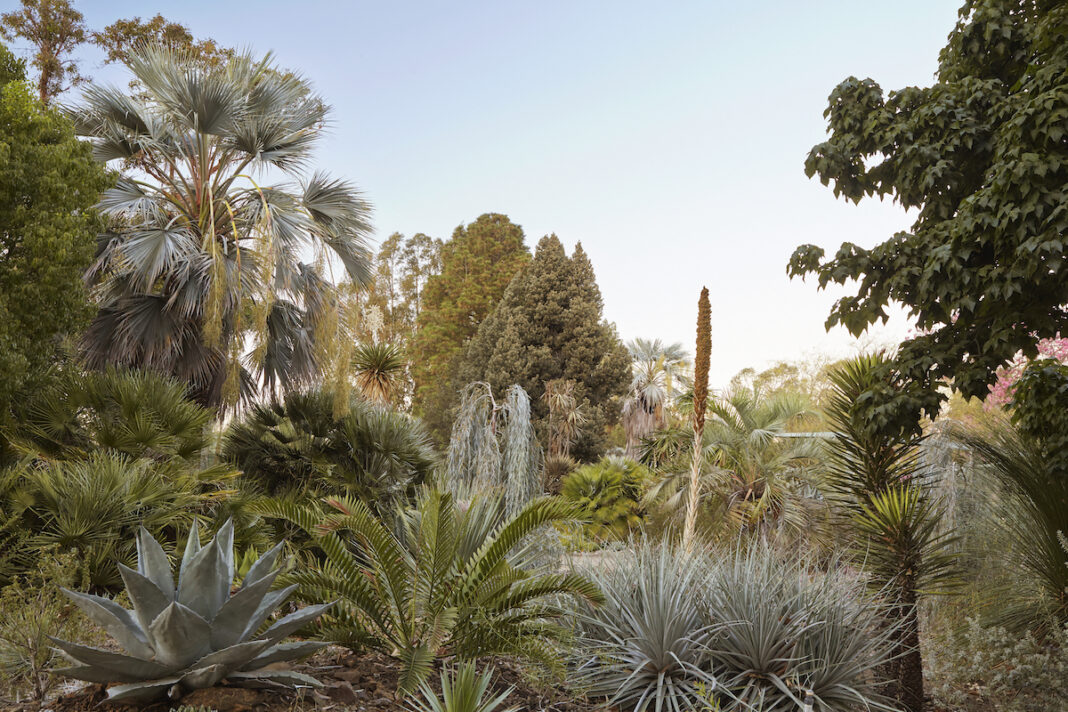Legacy gardens tell vast stories. Features of the landscape describe in hills, valleys, soil, rocks, boulders, wetlands, streams and ponds a location’s geographic history. The trees, plants, grasses, flowers, vegetables, fruits, insects and other biological forms of natural life illustrate and animate modern-day preferences, practices, aesthetics and even cultural influences. In a garden, the narrative becomes global, revealing how humans will—or will not—protect, preserve and ensure the planet continues to provide sustenance, beauty and pleasure for future generations beyond our own.
The Ruth Bancroft Garden in Walnut Creek tells all these stories and, marvelously, makes them available to the public. At 3.5 acres, the garden was decades ago established as a private garden for Bancroft’s immense collection of succulents, cacti and drought-tolerant plants. The garden in 1992 became a nonprofit open to the public under the auspices of The Garden Conservancy, a national organization inspired by Bancroft that preserves private gardens for public use.
Today, in 2023, the garden maintains most of the original physical footprint and is semi-cloistered behind a stucco wall and tall bushes on Bancroft Boulevard in Walnut Creek. Except for those who look up and note the towering tops of mature yuccas or pass by open front gates and catch a glimpse of agaves as big as pickup trucks, most people zipping along in their vehicles never know they are driving past a magical space.
For the rapidly growing number of people who do know or are learning of the garden and its robust programs, classes, events and sales, it’s become a community hub, a place to learn, share, celebrate and develop the pioneering California gardener’s vision.
The Ruth Bancroft Legacy
Bancroft was born Ruth Petersson in Massachusetts in 1908. She grew up in Berkeley with a father who was a classics professor at UC Berkeley, and a mother who was a school teacher. Wildflowers and amphibians were her companions. During her teens, her plans to become a landscape architect were scuttled by the Great Depression. Even so, she graduated from Cal with a teaching certificate in 1932.
On a blind date, she met Philip Bancroft Jr., whose family owned a 400-acre pear and walnut orchard in Ygnacio Valley. In the early 1970s, Bancroft began to apply her architectural skills and autodidactic preoccupation to a personal garden, after discovering her first aeonium during a shopping trip.
Initially, that garden was typical, but had an irrigation system designed by Theodore Osmundson, a well-known landscape architect. The system allowed Bancroft to stop watering her growing garden with a hose. What had begun as an obsession for tiny potted succulents became the basis for Bancroft’s radical-for-the-times ideas and meticulous record-keeping that have in the years since dramatically influenced dry-garden practices.
Conceptually revolutionary design ideas were things such as including ponds in dry gardens as cooling agents and audible and visual reminders to consider how water is preserved and re-purposed; mounding soil to improve drainage and allow for more plant diversity; including rocks and boulders to mimic natural environments; and garden designs with narrow, winding gravel paths that increase human interactions and including open vistas to create visual spaciousness and connect a garden to the larger surrounding area.
With a private residence on the property, until the very last few years of her life, Bancroft could be found working, eventually overseeing the garden from a wheelchair or escorted on the arm of an assistant. She died in November 2017 at the age of 109.
The Garden Today
In 2023, the garden boasts a visitor’s center, educational programs, docent-led tours, plant sales, special concerts, private rentals, and art and sculpture exhibits. A registered non-profit since 1992, The Ruth Bancroft Garden is run by a volunteer board of directors with approximately 20 paid staff members and a few interns.
Nursery and design services director Cricket Riley first joined the garden as a member in 2012. “I found the garden attractive and admired the climate-appropriate plants,” says Riley. “I used them as a source of inspiration and information for my gardens at home.”
Having moved into her position in 2017, Riley appreciates that most people in California are knowledgeable about planning for droughts, accessible irrigation and creating beautiful gardens that survive in today’s wildly changeable climate that might include unexpected and scorching heat waves in fall months and atmospheric rivers during the summer.
Even so, there are gaps in understanding home gardens. “We try to help clients understand how a tree, a fence, houses and hardscaping can feed into their gardens’ microclimate,” Riley says. “You can actually see it here in the Bancroft garden. In the shadier parts of our garden, you can grow plants that might need less sun. We’ve created artificial microclimates, like in Bed 6, that have a permanent shade structure that protects it from the sun and heat in the summer. In the fall, we put plastic sheeting on the structure that protects the plants from the rain. It’s like a portable greenhouse.”
In the workshops and classes she leads, Riley emphasizes intentionality about using water. The concept of hydro-zoning teaches people that if they have a water-hungry plant they love and want in their home garden, it’s possible to have it; simply surround it with other plants that use less water.
Another misconception? “We look at succulents that you mix in with other things for a variety of texture and color,” says Riley. “People think it’s a cactus or succulent garden only and you can’t have flowers. We show them you can have an agave next to a native salvia that is soft and pretty. It offers a more varied composition. Changing people’s minds about integrated gardens is what we do now.”
Riley says container gardening is an opportunity to create wonder in tiny spaces, and letting go of enormous grass front lawns and backyards is a matter of urgency. “The idea you have to have a grass lawn for your home to look proper, or cleaner…especially younger people seem open to breaking with tradition and interested in having a garden or lawns that don’t waste water or cause pollution. They use water on their fruit trees, not lawns.”
With a design aesthetic she calls “wild modern,” Riley says the phrase does not refer to “modern” as in restrained color palette and lots of repetition. Adding “wild” results in designs that instead feature overgrown plants that touch, an overall density of plants with variable textures and garden beds with plants “falling all over each other and having softness.”
During the pandemic shutdown, the garden saw a surge in sales, membership and participation. “We could provide so much benefit for the community,” says Riley. “The garden had a huge visitor increase because we could be open when others weren’t. Yes, the current economic situation has constricted those numbers, just like it has in all retail sales. People are more able to travel and do other things, so they might not be coming here to visit the garden as much as during COVID.”
The Garden in the Future
Asked about the coming years as a small staff devoted to Bancroft’s vision carries forth her legacy, Riley says, “We’d like to continue to see more people in our community find us as a resource. From homeowners to schools to civic organizations, we’re an example of sustainability, and we’re already woven into the fabric of the community.”
Riley’s big dreams are to change the way all gardens are taken care of, provide education at low- or no-cost to gardeners who have limited access to fine gardening skills, and for the Bancroft to help communities be involved in plant choices for gardens and parks in public spaces through a consulting program.
For homeowners seeking information and exploring the garden’s many programs and events, an updated website offers a detailed calendar, videos and information about a new Dry Garden Design Certificate Program launched this year. Visit ruthbancroftgarden.org for more information.











